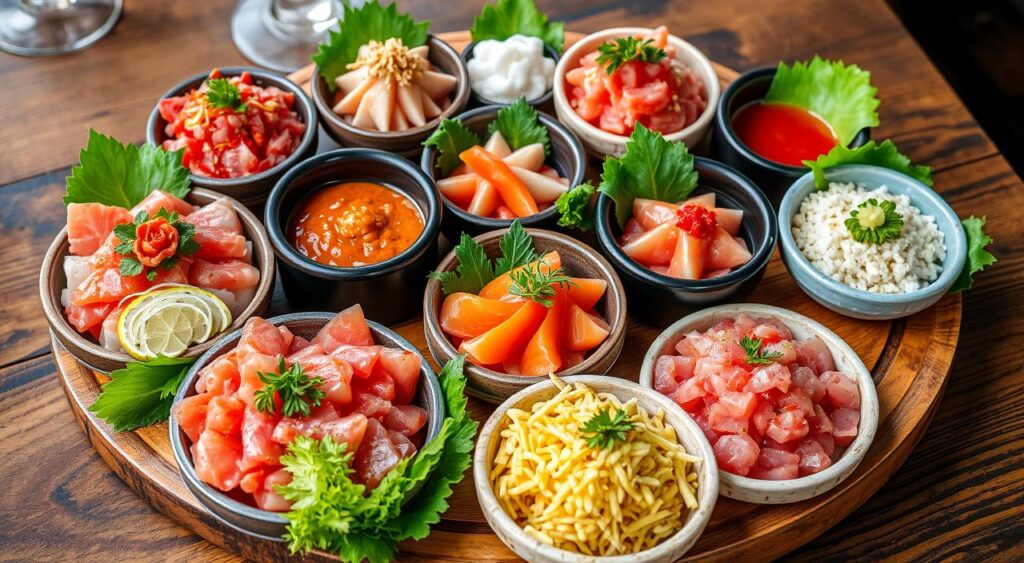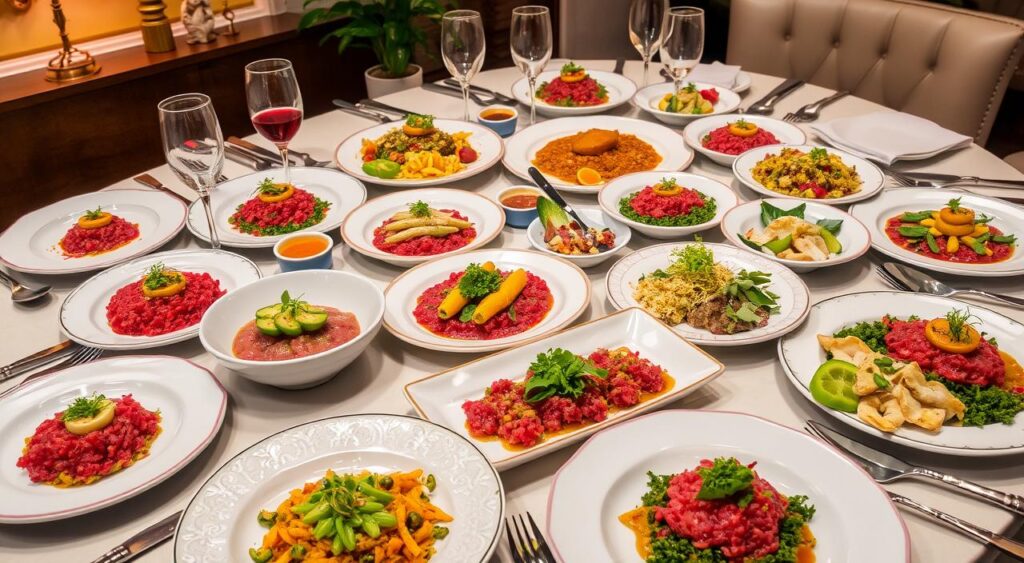Start a tasty journey into the world of tartar food. This raw delight has won hearts worldwide. It offers a special and exciting taste experience.
From its many origins to its rich tastes and textures, we’ll explore tartar food together. You’ll learn how to make it, its cultural importance, and its health perks.
Key Takeaways
- Discover the origins and history of tartar food
- Explore the diverse range of tartar cuisine, from seafood tartare to beef tartare
- Learn about the unique flavors and textures that define tartar dishes
- Understand the cultural significance and global popularity of tartar food
- Discover tips and techniques for preparing delectable tartar dishes at home
What is Tartar Food?
Tartar food, also known as tartare, is a dish made from raw, finely chopped meat or seafood. It has a rich history, starting with nomadic societies in Central Asia. The dish uses fresh proteins like beef, tuna, salmon, or scallops, mixed with tasty seasonings and condiments.
Exploring the Origins and Ingredients
The term “tartar” comes from the Tatar people, nomadic tribes in Central Asia. They were experts at making raw, seasoned meat dishes. These dishes were nutritious and easy to carry.
Over time, tartar cuisine picked up influences from different cultures. This made it diverse and exciting.
The main ingredients in tartar are fresh, high-quality proteins. They are chopped or minced for a unique texture. Common proteins include:
- Beef: Filet mignon or other tender cuts are often the protein of choice for classic beef tartar.
- Tuna: Fresh, sushi-grade tuna is a popular option, adding a delicate and slightly sweet flavor to the dish.
- Salmon: Wild-caught salmon brings a rich, buttery taste and vibrant color to tartar preparations.
- Scallops: Delicate, tender scallops can also be used in tartar, lending a sweet and delicate flavor profile.
These proteins are mixed with seasonings and condiments. Capers, shallots, Dijon mustard, Worcestershire sauce, and raw egg yolk are used. They create a delicious and balanced taste.
“Tartar food is a culinary adventure that celebrates the purity and freshness of high-quality proteins, elevating them with a symphony of flavors and textures.”
The Tantalizing Flavors of Tartar Cuisine
Tartar food has a unique flavor profile. It’s a mix of freshness, richness, and subtle nuances. The raw proteins used in tartar cuisine let the natural flavors shine. Aromatic herbs, tangy condiments, and crunchy garnishes add a delightful contrast of textures and taste sensations.
Enjoying a tuna tartare’s delicate sweetness or a classic beef tartare’s bold taste is a remarkable experience. The flavor profile of these dishes is like a symphony. Each ingredient plays a key role in creating a balanced and captivating taste of tartar dishes.
The texture of tartar cuisine is also exciting. Soft, tender proteins contrast with fresh vegetables, tangy condiments, and rich sauces. This mix of textures and flavors makes tartar food a true delight for the senses.
“Tartar cuisine is a culinary adventure that awakens the palate and leaves a lasting impression. The pure, unadulterated flavors and innovative combinations make each bite a delightful discovery.”

From the delicate tuna tartare to the bold beef tartare, the flavors of tartar cuisine are captivating. Whether you’re a seasoned foodie or new to exploring, tartar food offers an unforgettable culinary journey.
Tartar Food: A Global Culinary Phenomenon
Regional Variations and Cultural Influences
Tartar food has become popular worldwide, with many different versions. From French steak tartare to Japanese maguro no yukke, each place has its own twist. This shows how different cultures have influenced this exciting food.
In the Middle East, kibbeh nayyeh is a mix of minced lamb or beef, bulgur, onions, and spices. Korean yukhoe is known for its bold flavors, with raw beef, pear, and a sweet soy sauce.
| Tartar Dish | Region | Key Ingredients |
|---|---|---|
| Steak Tartare | France | Raw beef, egg yolk, capers, onions, Worcestershire sauce |
| Maguro no Yukke | Japan | Raw tuna, soy sauce, sesame oil, scallions, perilla leaves |
| Kibbeh Nayyeh | Middle East | Raw lamb or beef, bulgur, onions, Middle Eastern spices |
| Yukhoe | Korea | Raw beef, pear, soy sauce, sesame oil, scallions |
These variations show the diversity of tartar food worldwide. They also highlight the cultural impact on its evolution. The global popularity of tartar food, with its different tartar dishes around the world and cultural influences on tartar cuisine, makes it a fascinating culinary journey.

Preparing Mouthwatering Tartar Dishes at Home
Making tartar dishes at home is a fun adventure in cooking. It lets you explore the rich flavors of raw food. To make a great tartar, you need to chop the protein right, season it well, and add the perfect sides.
Essential Techniques and Tips
Want to make a classic beef tartare or try something new with seafood? This section has all the tips you need. You’ll learn how to pick the best ingredients and present your dish beautifully. These expert tips will make your tartar dishes stand out.
Check out different tartar recipes, from old favorites to new twists. You’ll learn the basics of making tartar. This includes chopping the protein just right, seasoning it to bring out the flavors, and adding the right sides. With these tips, every bite will be a burst of deliciousness.
FAQ
What is tartar food?
Tartar food, also known as tartare, is a dish made from raw, finely chopped meat or seafood. It comes from nomadic societies in Central Asia. This dish has a rich history.
What are the key ingredients in tartar food?
Tartar food uses high-quality, fresh proteins like beef, tuna, salmon, or scallops. It also includes flavorful seasonings and condiments.
What is the flavor profile of tartar cuisine?
Tartar food has a unique flavor profile. It’s fresh, rich, and full of subtle nuances. The raw proteins let their natural flavors shine.
Adding aromatic herbs, tangy condiments, and crunchy garnishes adds to the experience. It creates a mix of textures and tastes.
How has tartar food become a global culinary phenomenon?
Tartar food has grown from its humble start to become a global hit. It’s found in many cuisines worldwide. Each place adds its own twist, using local ingredients and flavors.
This makes tartar food a diverse and exciting experience.
How can I prepare mouthwatering tartar dishes at home?
Making tartar dishes at home is a fun journey. It lets you discover the richness of raw food. To make great tartar, learn to chop the protein right.
Balance the seasoning and choose the right accompaniments. This will help you create a perfect tartar dish.
Next Post: Delicious Gluten Free Pound Cake Recipe | Easy Bake

